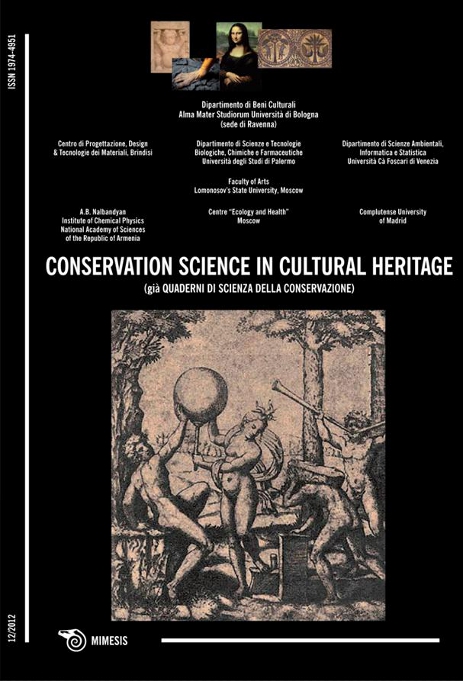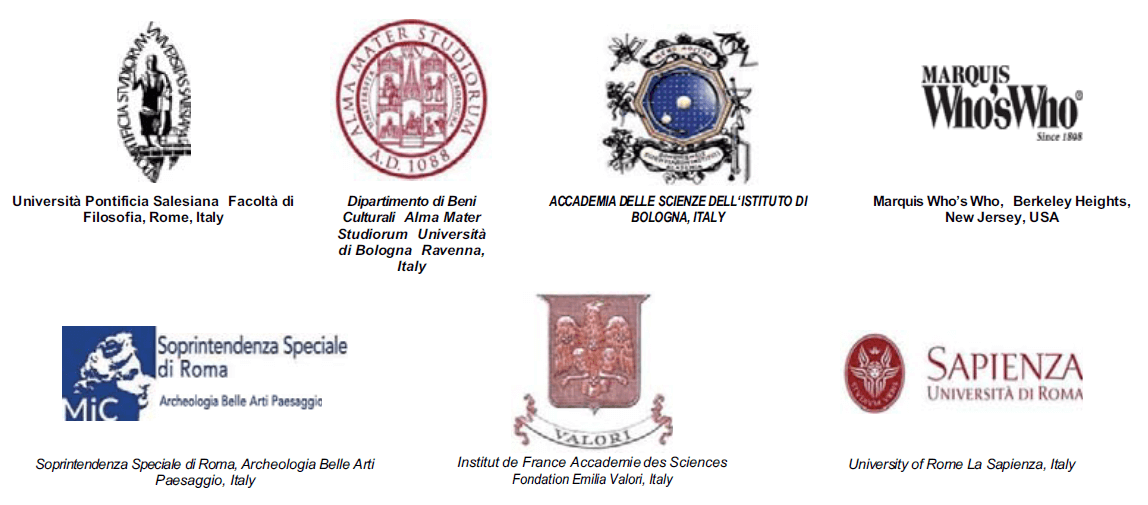Art and environment as media for ecosustainability, ethics and aesthetics
DOI:
https://doi.org/10.6092/issn.1973-9494/3382Keywords:
art, ecosustainability, ethics, aesthetics, educationAbstract
“Art, both in a strict sense, but also in a broader sense, that is to say environmental and cultural heritage – considering, as it correctly should be, the environment with its individual compartments of air, soil and water – is indissolubly linked to the history of man”. It can be said, consequently, that the various artistic expressions and different generational periods, in the course of the numerous social happenings and problems which have occurred over the years up to the present day, are temporally connected to each other, because “the past is part of our future and our future is founded on our past”. This reality is pragmatically the basis for the activities of education and research in which I am engaged at the Department of Cultural Heritage at the Alma Studiorum University of Bologna. In fact, in dealing with problems related to the protection and valorization of cultural and environmental heritage through the use of diagnostic-analytical technologies, the experiences and historical-technical case histories of the artefacts examined, that is to say their “past”, cannot not be regarded and evaluated when projecting their study and conservation into the “future”. The content of the present paper is based on these initial considerations, also in relation to the correct and comprehensive education of young people in the field of the protection and valorization of cultural and environmental heritage.
Riassunto
“L’arte, in senso lato e stretto ad un tempo, ovvero il patrimonio culturale e ambientale – considerando correttamente come tale anche l’ambiente con i suoi comparti aria, suolo, acqua – è legata alla storia dell’uomo”. In relazione a ciò, le varie espressioni artistiche e, quindi, le varie ondate generazionali, con accadimenti e problematiche della società nel corso del tempo fino ai nostri giorni, sono fra loro collegate temporalmente, in quanto ”il nostro passato è parte del nostro futuro e il futuro poggia sul nostro passato”. Tale verità è pragmaticamente alla base delle attività di formazione e di ricerca del sottoscritto presso la Facoltà di Conservazione dei Beni Culturali dell’Alma Mater Studiorum Università di Bologna. Infatti, nell’affrontare le problematiche relative alla tutela e valorizzazione del patrimonio culturale e ambientale con l’impiego di tecnologie diagnostico-analitiche, non si possono non considerare e valutare i trascorsi storici e storico-tecnici dei manufatti sottoposti allo studio e, quindi, il loro “passato”, proiettando le indagini e l’intervento conservativo al “futuro”. Su queste iniziali considerazioni poggia, appunto, il contenuto del presente intervento, anche in relazione alla corretta e completa formazione dei giovani nell’ambito della tutela e valorizzazione del patrimonio culturale e ambientale.
Résumé
« L’art, au sens large et étroit en même temps, c’est-à-dire le patrimoine culturel et environnemental – considérant correctement comme tel aussi l’environnement avec ses compartiments air, sol, eau – est lié à l’histoire de l’homme ». Par rapport à cela, les différentes expressions artistiques et, donc, les différentes vagues générationnelles, avec les événements et les problématiques de la société au cours du temps jusqu’à nos jours, sont reliées entre elles temporellement, étant donné que « notre passé fait partie de notre futur et le futur s’appuie sur notre passé ». Cette vérité est pragmatiquement à la base des activités de formation et de recherche du soussigné auprès de la Faculté de Conservation des Biens Culturels de l’Alma Mater Studiorum Università de Bologne. En effet, en affrontant les problématiques relatives à la tutelle et à la valorisation du patrimoine culturel et environnemental avec l’emploi de technologies diagnostico-analytiques, on ne peut pas ne pas considérer et évaluer le passé historique et historique-technique des ouvrages soumis à l’étude projetant ainsi les enquêtes et l’intervention conservative au « futur ». Sur ces considérations initiales se base, justement, le contenu de la présente intervention, en relation aussi à la correcte et complète formation des jeunes dans le cadre de la tutelle et de la valorisation du patrimoine culturel et environnemental.
Zusammenfassung
„Kunst im weiteren und engeren Sinne, beziehungsweise Kultur- und Umweltgut - vorausgesetzt, dass unter anderem von der Korrektheit der Einbeziehung von der Umwelt untergeordneten Bereichen wie Luft, Boden und Wasser ausgegangen wird - ist eng mit der Menschheitsgeschichte verknüpft”. Entsprechend sind die unterschiedlichen künstlerischen Ausdrucksweisen und somit die verschiedenen Generationswellen, einschließlich der im Verlauf der Zeit bis heute aufgetretenen problematischen gesellschaftlichen Vorkommnisse, zeitlich miteinander verbunden, denn „unsere Vergangenheit ist Bestandteil unserer Zukunft so wie unsere Zukunft an unsere Vergangenheit anlehnt”. Diese Wahrheit bildet die pragmatische Grundlage meiner Ausbildungs- und Forschungsaktivitäten an der Fakultät für Denkmalpflege in der Alma Mater Studiorum Universität Bologna. Tatsächlich kommt man im Rahmen einer Konfrontation der bezüglich dem Schutz und der Valorisierung des Kultur- und Umweltguts unter Anwendung diagnostischanalytischer Technologien auftretenden Problematiken nicht umhin, historische und historisch-technische Vorkommnisse der den Gegenstand der Untersuchung bildenden Manufakte und somit deren “Vergangenheit” zu berücksichtigen. Dies erfordert, dass Untersuchungen und denkmalpflegende Eingriffe auf die “Zukunft” projiziert werden. Auf diese anfänglichen Überlegungen baut der Inhalt dieses Eingriffs auf. Dies gilt auch in Bezug auf die korrekte und umfassende Ausbildung junger Menschen im Bereich des Schutzes und der Valorisierung von Kultur- und Umweltgut.
Resumen
“El arte, en su sentido lato y estricto al mismo tempo, o sea el patrimonio cultural y medioambiental – incluyendo correctamente también el medioambiente formado por aire, suelo, agua – está relacionado con la historia del hombre”. Por tanto, las varias expresiones artísticas y, por consiguente, las varias oleadas generacionales, con sucesos y problemas de la sociedad a lo largo del tiempo hasta hoy en día, están vinculadas entre sí a nivel temporal, ya que “nuestro pasado forma parte de nuestro futuro y el futuro descansa en nuestro pasado”. Dicha verdad representa pragmáticamente el fundamento de las actividades de formación e investigación del autor en la Facultad de Conservación de Bienes Culturales del Alma Mater Studiorum Universidad de Bologna. De hecho, al enfrentar los asuntos relacionados con la protección y la valorización del patrimonio cultural y medioambiental mediante el uso de tecnologías diagnóstico-analíticas, hace falta considerar y evaluar los antecedentes históricos e histórico-tPcnicos de las obras estudiadas y, por tanto, su “pasado”, dirigiendo las investigaciones y la intervención conservadora hacia el “futuro”. Estas consideraciones iniciales constituyen la base del contenido de este artículo, también en relación con una correcta y completa formación de los jóvenes en el cam- po de la protección y valorización del patrimonio cultural y medioambiental.
Резюме
«Исскуство в широком и узком смысле слова, то есть культурное и природное наследие – подразумевая при этом окружающую среду и ее составляющие: воздух, почву, воду – связано с историей человека».В связи с этим различные художественные выражения и, следовательно, различные смены поколений с общественными событиями и проблемами на протяжении веков и до наших дней связаны между собой во времени, поскольку «наше прошлое является частью нашего бедущего и будущее опирается на наше прошлое».Данная правда лежит в основе нашей исследовательской и преподавательской деятельности, имеющей место при Факультете Сохранения культурного наследия Болонского университета. Действительно, при преодолении проблем по сбережению культурного и природного наследия и придатия ему ценности, используя диагностико-аналитические технологии, нельзя не учитывать и не оценивать историческое и историко-техническое прошлое предметов, подвергающихся изучению, и, следовательно, их «прошлое», проектируя исследования и действия по сохранению к «будущему».На этом основывается данная статья, а также на правильное и полное образование молодежи в области сохранения и ценности культурного и природного наследия.
Ամփոփում
«Արվեստ, լայն եւ նեղ իմաստով միաժամանակ, կամ որ մշակութային եւ բնապահպանական ժառանգություն, հաշվի առնելով, որ այդ միջավայրը իր մեջ պարունակում է օդ, հող, ջուր, կապված է մարդու պատմությանը»: Հետևաբար, տարբեր արտիստական արտահայտություններ և հասարակության տարբեր հոսանքները, դեպքերը և պրոբլեմները ժամանակի ընթացքում մինչև մեր օրերը, իրար հետ կապված են, քանի որ «մեր անցյալը մեր ապագայի մասն է եւ ապագան հիմնվում է անցյալի վրա”: Այս պրագմատիկ ճշմարտությունը գիտահետազոտական և ուսանողների ձևավորման հեղինակի գործունեության հիմքն է Բոլոնիայի համալսարանի (Alma Mater) մշակութային ժառանգության պահպանության ֆակուլտետում:Ըստ էության, հարցերը վերաբերում են ախտորոշման և վերլուծական տեխնոլոգիաների միջոցով, մշակութային ժառանգության և բնության պաշտպանության ու ամրապնդմանը, չի կարելի չդիտարկել և չգնահատել պատմական անցյալի պատմական և տեխնիկական արտեֆակտերի ուսումնասությանը և, հետևաբար, իրենց «անցյալը», նախագծային քննությունը և պահպանման աշխատանքը `” ապագան “: Այս նախնական նկատառումների վրա է հիմնվում ելույթը և `կապված է երիտասարդների ճիշտ և ամբողջական ձևավորումից մշակութային ժառանգության եւ բնապահպանության պաշտպանության ու ամրապնդման գործում:
References
LORUSSO S., MARABELLI M., VIVIANO G., 2006, La contaminazione ambientale ed il degrado dei materiali di interesse storico-artistico, Pitagora Editrice Bologna
LORUSSO S., MATTEUCCI C., NATALI A., 2010, Il mercato dell’arte e le case d’asta: valutazione diagnostico-analitica e economico-finanziaria. L’autentico, il falso, il riprodotto nel settore dei beni culturali, Pitagora Editrice Bologna
LORUSSO S., 2010, Editorial, Conservation Science in Cultural Heritage, 10, pp.9-14
BARILLI R., 2011, Arte e cultura materiale in occidente, Bollati Boringhieri Editore, Torino
LORUSSO S., Art and Environment as media for Ecosustainability, Ethics and Aesthetics, Education Project “Rio + 20 – Difficult way to sustainability” devoted to the 25th anniversary of Open Ecological University, 6-10 april 2012, M.V. Lomonosov University, Moscow
LORUSSO S., NATALI A., VOLPE F., 2009, The traditional, the innovative, the ephemeral: conception, realization, intervention in contemporary art, Conservation Science in Cultural Heritage, 9, pp. 170-214
NATALI A., 2008, Some considerations on conservation and restoration in con S. Lorusso, A. M. Braida - Art and environment as media for ecosustainability, ethics and aesthetics temporary art, Conservation Science in Cultural Heritage, 8, pp. 187-197
ALÌ M., 2011, The internazionalization of Research, Conservation Science in Cultural Heritage, 11, pp. 33-48
LORUSSO S., MATTEUCCI C., NATALI A., VISCO V., 2006, Diagnostic investigations and historical-stylistic evaluation on the oil painting: “reading man by oil lamp light”, Quaderni di Scienza della Conservazione, 6, pp. 117- 137
LORUSSO S., NATALI A., MATTEUCCI C., 2007, Colorimetry applied to the field of cultural heritage: examples of study cases, Conservation Science in Cultural Heritage, 7, pp. 187- 220
LORUSSO S., NATALI A., MATTEUCCI C., BERTOLINO R., TUMIDEI S., 2007, Diagnostic investigation and historical-stylistic evaluation of oil painting on metal board. Example of “Christ Crucified with two mourning angels, Conservation Science in Cultural Heritage, 7, pp. 351- 378
Downloads
How to Cite
Issue
Section
License
Copyright (c) 2012 Salvatore Lorusso, Angela Braida
Copyrights and publishing rights of all the texts on this journal belong to the respective authors without restrictions. Authors grant the journal right of first publication.
This journal is licensed under a Creative Commons Attribution 4.0 International License (full legal code).
See also our Open Access Policy.






